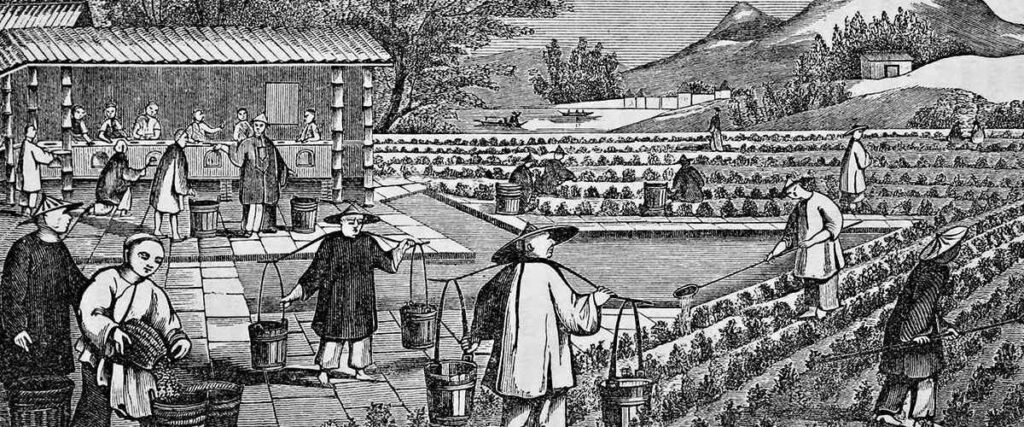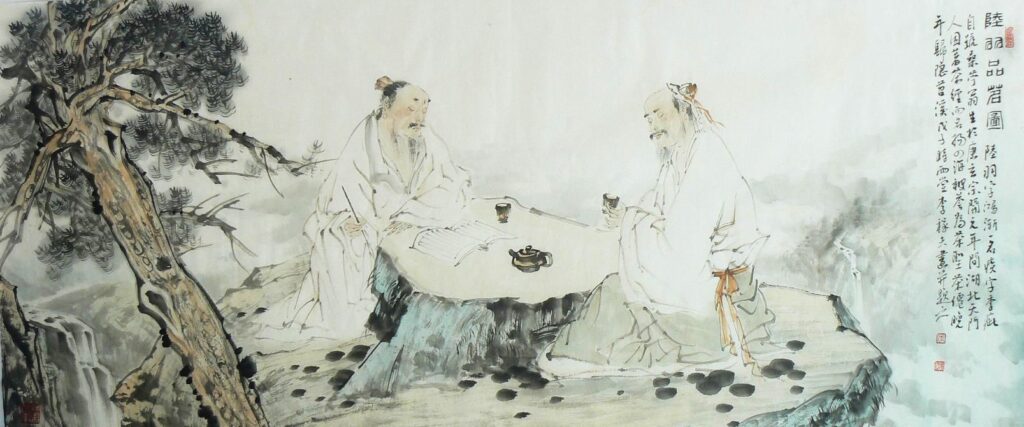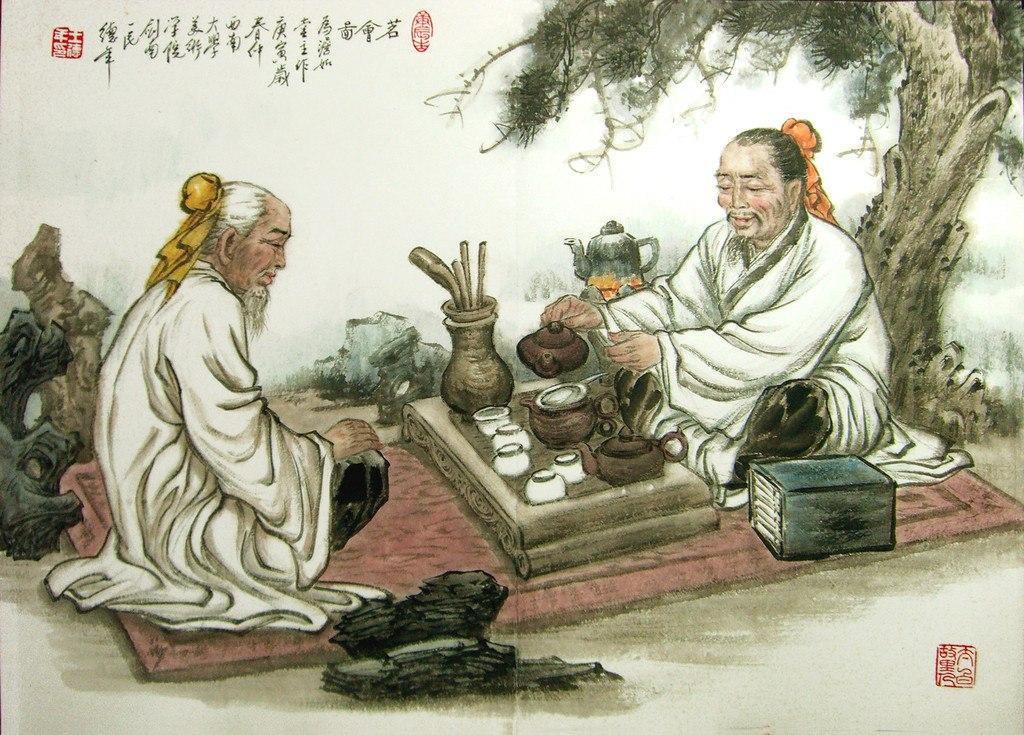Yes, and in reality, if we deviate from the legend of Chinese tea, then … Long time ago, the legend says, the patron saint of agriculture and medicine Shen Nong, traveling around the country in search of healing herbs, boiled water in his tripod for another decoction. And a few leaves from the tea tree fell into the water. Having tasted the resulting drink, Shen-nong never drank anything else, it turned out to be so tasty and invigorating. So in ancient times, tea appeared in China. And tea from China spread throughout the world over time: it is not for nothing that the word “tea” in most languages is borrowed from Chinese.
There is another version of the legend about Shen Nong: since he was looking for new medicinal herbs, he had to try many different ones, including poisonous ones. And when he tried another poisonous herb, he washed it down with tea, and the tea helped the body get rid of the poison. By the way, tea does have this effect, it is not without reason that when we are poisoned, we begin to drink strong black tea.
And in reality, if we deviate from the legend of Shen-nung, initially the leaves of the tea bush (Camellia sinensis) were used as a medicine, and only then (which is also associated with many legends) turned into an everyday drink. And the process of making tea is much more complicated than the legendary “brew a few leaves from a bush.” Over time, the Chinese invented many ways to process tea leaves, from the simplest to the most complex technology.
Depending on the processing technology of the tea leaf, teas are divided into several large groups: white teas, green, yellow, oolong, red, black, pu-erh. As a rule, for teas belonging to different groups, the leaf is also collected from different bushes: there are already under 300 varieties of Camellia sinensis at the moment. However, it is quite possible to take a leaf from an oolong bush, for example, and make red tea. And they do this periodically to get new interesting varieties.
So, the key difference between teas of different groups is the technology of processing the tea leaves after assembly, on which the degree of tea fermentation depends. Depending on this, teas are divided into: green, white, yellow, red, oolong (or turquoise), pu-erh and black teas.
White Chinese tea
The lightest, thinnest and freshest. As it may seem, this tea is the easiest to process, because after harvesting it is only dried. However, it is dried alternately in the sun and in the shade, and when drying, factors such as sun, humidity and even blowing are taken into account (if there is no wind, it is blown with special fans, and if the wind is too strong, then they put up a barrier). Raw materials for white tea are taken only the most tender – the kidney and upper leaves. The main place of production of white tea is the Fuding district of Fujian province (on the coast of the East China Sea).
White tea is harvested in spring. Such tea is not stored for long, you can open the box and drink after five years. Another thing is that freshness is most critical for this tea. The fresher, the tastier. So, if you are already buying, take only the crop of the current year. True, in recent years, the so-called “old” white tea has been gaining popularity. This is the same white, but lain down for several years in a dry place without extraneous odors. It is believed that this is more of a marketing ploy so that you can sell stale tea of the past, but the old white tea has its fans.
You can brew white tea, in contrast to the established opinion, even with boiling water. True, if you brew with boiling water, all the imperfections of the sheet (if any) will be immediately felt. Ideal – 95 degrees. And so you can brew with cool water, just insist longer.
The most common varieties of white tea are Baimudan (white peony) and Baihao Yinzhen (hairy silver needles).
Green tea from China
– tea, which everyone immediately remembers when they hear the phrase “Chinese tea”. And for good reason, because it is the most popular tea in China. There are a lot of green teas, they are made in various provinces of China. These teas, like white teas, undergo minimal fermentation, so that the taste remains light and fresh. However, the processing of greens is already a little more serious (they are dried and often fried a little), so their tastes and aromas are brighter. But at the same time, tea is not fermented strongly, so the leaf retains many useful substances.
There are a lot of green Chinese teas. Among the most famous varieties are Long Jing (Dragon Well from Hangzhou), Biluochun (Emerald Spirals) from Jiangsu, Mao feng (hairy needles) from Huangshan Mountain and many others.
Green tea is traditionally brewed in a glass and can be brewed with regular steeping, as is customary in Ukraine, although better teas can be brewed with richer flavors when steeped. Water for green is better to cool a little before brewing.
By the way, like white teas, green teas can be brewed with water of different temperatures: good Chinese tea will not be spoiled even by brewing with boiling water. And green and white can be brewed even in cold water: just leave it to infuse for a longer time – and you will get a wonderful refreshing infusion.

Yellow Chinese tea
Produced in only a few places in China. For its production, only the best raw materials are taken – a tender kidney or kidney and two upper leaves that have just separated from it, so there are no cheap yellow teas. Yellow ones are immediately elite varieties. For a long time, yellow tea was considered imperial and was protected from ordinary people and foreigners. According to the degree of fermentation, yellow is in third place after white and green teas, and “languishing” in large bags is added to the process of its processing.
This is a very complex technological process that requires careful control of the degree of fermentation and temperature. Simmering gives yellow tea a special flavor, similar to the taste of baked milk. But brewing yellow tea requires special skill: incorrect brewing is likely to give just a tasteless drink.
Red tea
So we got to red tea. We used to call these teas black, but for the Chinese they are red, and Chinese teas are lighter than Indian teas, so we will stick to the Chinese name. Red tea is highly fermented. It can be stored for a long time, it does not deteriorate from this. Initially, red teas were invented for export, because green teas spoiled during transportation. But now there are a lot of fans of red in China. The main provinces where red tea is produced are Fujian and Yunnan. Famous varieties include Dianhong, Jing jun mei (Golden Eyebrows), Yixing Hongcha (Yixing Red), or Zheng shan xiaozhong (small shrubs from Zhengshan Mountain).
It is better to brew red tea, if it has buds and golden hair, with cooler water than other teas – 85-90 degrees is optimal. If the tea leaf is saturated red-black, glossy, then you can brew it with hotter water: 95-100 degrees.
Black tea.
Yes, there is one in China. But this is not the black that we are used to, Chinese red is closest to it. Black Chinese tea is one that has undergone additional processing after fermentation, that is, after the completion of the enzymatic processes, it has also been exposed to special bacteria and fungi. The fungus in this tea has an antiseptic effect, so it is considered quite beneficial. For the production of black teas, most often coarse raw materials are taken – a large leaf, often from tea trees, and not from bushes.
It is believed that black tea is very good for health, helps against infections, removes toxins and cholesterol. But the taste of this tea is quite specific. Black teas are produced in several provinces of China. By the way, black pu-erh (shu pu-erh) is also often referred to as black tea, since it was the technology of their production that provided the basis for the invention of shu pu-erh.
Here is a classification of teas according to fermentation methods. But in fact, this is not all types of Chinese tea. Or rather, in China there are several more types of teas that do not fall into this classification or fall partially. Let’s talk about them.

flower tea
He is herbal – it is often not even tea in the full sense of the word. These are other plants and herbs that are simply brewed in the same way as tea, so the Chinese, for simplicity, also call them tea. For example, chrysanthemum or rose flowers, goji berries, osmanthus flowers and many other flowers, herbs, roots and berries. They can be brewed on their own or mixed with tea leaves. Sometimes they are also called “tea additives” in Russia.
Flower Chinese teas, as a rule, are always medicinal – each has some useful property. For example, they help with colds or reduce blood pressure. Sometimes they are not even sold under their own name – herbs or flowers, but are called effects on the body: tea for the kidneys, tea for the heart. They can be sold both in the market and in tea shops, however, they are unlikely to be specially offered to you there unless you ask.
There is also such a type of tea as connected . This attraction is not so much a taste attraction as a visual attraction: bound tea is a large ball that, when brewed, blooms like a flower. More precisely, there is a flower inside and even, at times, more than one. It is best to brew bound tea in transparent glassware, pouring boiling water at least 10 centimeters in height, since a branch with a small flower can “grow” from a blossoming bud.
Bound tea is very beautiful: it dissolves slowly and smoothly, and then you can drink the infusion all day, adding boiling water. Bound teas are essentially green or green flavored teas (mostly jasmine). They are average in quality – they will not go to the ceremony, but as table tea to wash down a piece of cake – they will fit perfectly. By the way, tied tea is an excellent souvenir gift: one ball is cheap, but it will bring a lot of joy.
Well, we have already mentioned jasmine tea above . Very famous and, by the way, beloved by the Chinese too. It belongs to the class of flavored teas. Initially, real jasmine flowers were used for flavoring, added during the tea processing stages. But we ask you not to delude yourself: tea made in this way will have a very subtle note of jasmine. And it will cost a lot. And most of the flavored teas: pink, tea with lychee flavor, jasmine, milk oolong – all this is the addition of chemical flavors to tea.
Moreover, such teas can also vary in quality and cost. However, chemical flavors and dyes have long and firmly entered our lives. Like – drink to your health. Jasmine tea is generally considered a favorite tea among Beijingers. And they drink to themselves, not at all worrying about chemistry. By the way, if there are jasmine petals in tea, this also does not mean that there is no flavoring. And in general, the thinner and lighter the note of the additive, the higher the price, the greater the hope that there is no chemistry in it.
By the way, regarding the famous milk oolong: initially it was not flavored at all, just a certain tea bush growing in a certain area had a special milky note in taste and aroma. Fans of the standard milk oolong, which is sold with us, most likely will not recognize the real original.
And is it necessary? Each tea has its own buyer. Every fan has his own favorite. Our advice is only one: drink, taste and have fun. And do not buy what you do not like, even if it is a super-premium variety!
Traditionally, any tea in China is brewed with spills: about 5-7 grams of a tea leaf is placed in a teapot or gaiwan, poured with boiling water (the first brews are held for several seconds, then the infusion time gradually increases) and poured into a special container – chahai. Already from the chahai, the infusion is poured into bowls and drunk. Thus, the tea gradually opens up: at first you will feel a strong aroma, the taste will increase with the next tea leaves.
For most teas, the first infusion is drained, and the 3rd-4th is considered the most interesting. If you don’t want to bother with a bunch of dishes, but you are interested in trying to brew with straits, buy a tipod: this is a kind of teapot with a button. Glass types are sold in Russia almost in Auchan, it will not be difficult to find it. You can also brew by pouring in a regular teapot, pouring the tea directly into the cup.
If you are going on a tour to Tibet and China, tea is a great souvenir. But for those who do not understand tea, it is best to carry green or red tea. These teas are intensely flavored but require little skill in brewing and can be brewed by simply steeping them in a teapot or glass.
In large cities, as a rule, there are tea markets where you can buy tea, especially large markets – in Beijing and Guangzhou. When buying tea in China, it is customary to taste it: the seller will show you the tea leaf, and then brew it several times so that you can appreciate the taste and aroma of tea. Do not refuse, it’s free, moreover, buying tea without brewing is simply not accepted.
True, taking into account this approach, buying tea can take half a day, if not a day, because the seller can have several options for the same tea of different price categories. For example, Teguangyin for 50 yuan, for 100, for 300 and so on. Prices for Chinese tea per pound (unless the tea is pressed, then the price is per pancake).






